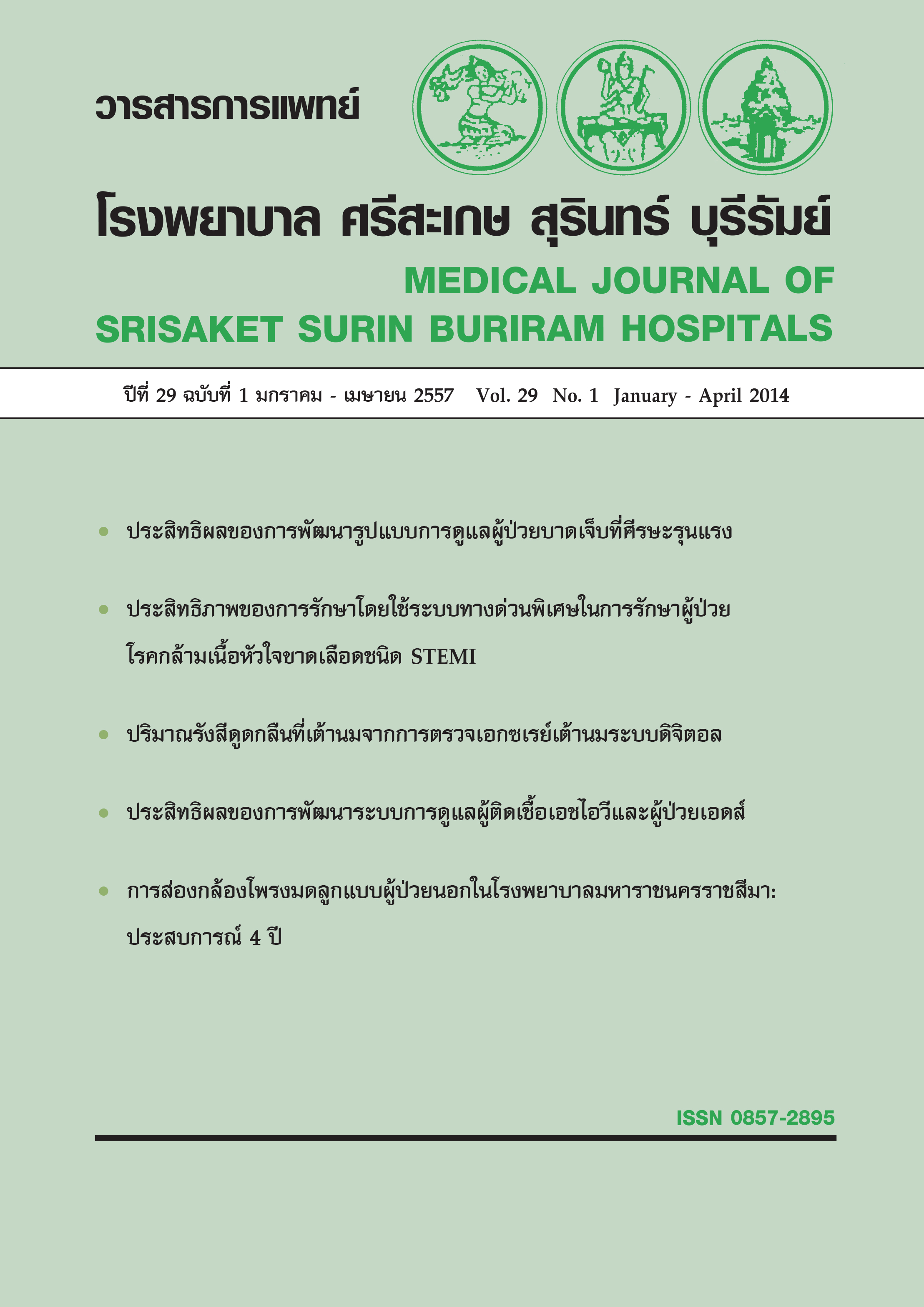ประสิทธิภาพของการรักษาโดยใช้ระบบทางด่วนพิเศษในการรักษา ผู้ป่วยโรคกล้ามเนื้อหัวใจขาดเลือดชนิด STEMI
Main Article Content
บทคัดย่อ
บทนำ: โรคกล้ามเนื้อหัวใจขาดเลือดฉับพลันชนิดมีการยกของคลื่นไฟฟ้าหัวใจส่วน ST segment (STEMI)
เป็นโรคที่มีอัตราตายสูง การรักษาผู้ป่วยต้องได้รับการเปิดเส้นเลือด (reperfusion therapy) โดยเร็วที่สุดเพื่อลดอัตราตายและภาวะแทรกซ้อนโดยบริบทของโรงพยาบาลบุรีรัมย์การให้ยาละลาย ลิ่มเลือดเป็นวิธีหลักที่ใช้ในการรักษาโดยมาตรฐานการรักษาโดยการให้ละลายลิ่มเลือดปัจจุบัน จะกำหนด มาตรฐานให้ผู้ป่วยได้รับยา(door to needle time) ภายใน 30 นาทีเมื่อมาถึงโรงพยาบาล การพัฒนา ระบบภายในโรงพยาบาลจึงเน้นการสร้างระบบที่มี door to needle time ที่ลดลง โรงพยาบาล บุรีรัมย์จึงได้ทำการพัฒนาระบบทางด่วนพิเศษในการให้ยาละลายลิ่มเลือดจากระบบเดิมการให้ยา ละลายลิ่มเลือดต้องย้ายผู้ป่วยไปให้ยาที่หอผู้ป่วยวิกฤติ ให้ยาที่ห้องฉุกเฉิน และนำระบบปรึกษา คลื่นไฟฟ้าหัวใจสำหรับการวินิจฉัยโดยผ่านทางโทรศัพท์มือถือที่มีไว้ประจำห้องฉุกเฉิน
วัตถุประสงค์การศึกษา: วัตถุประสงค์หลักเพื่อเปรียบเทียบระยะเวลา door to needle time ในการรักษาผู้ป่วยโรคกล้ามเนื้อ หัวใจขาดเลือดฉับพลัน STEMI วัตถุประสงค์รองเพื่อเปรียบเทียบระยะเวลา total ischemic time อัตราการเกิดภาวะแทรกซ้อนและอัตราตาย ระหว่างระบบการรักษาแบบเดิมกับระบบทางด่วนพิเศษ
สถานที่ทำการศึกษา: โรงพยาบาลบุรีรัมย์
วิธีการศึกษา: เป็นการวิจัยกึงทดลอง(Quasi-experimental study) ในผู้ป่วยโรคกล้ามเนื้อหัวใจขาดเลือดฉับพลัน STEMI ที่ได้รับการรักษาด้วยระบบเดิมเปรียบเทียบกับกลุ่มที่ได้รับการรักษาด้วยระบบทางด่วนพิเศษ โดยรวบรวมข้อมูลจาก แบบบันทึกข้อมูล Buriram STEMI registry ของผู้ป่วยโรคกล้ามเนื้อหัวใจ ขาดเลือดฉับพลัน STEMI ที่มารับการรักษาที่โรงพยาบาลบุรีรัมย์ กลุ่มที่ 1 (N=31) ได้รับการรักษา ด้วยระบบเดิม ทำการรวบรวมข้อมูลตั้งแต่ 1 ตุลาคม พ.ศ. 2553 ถึง 30 กันยายน พ.ศ. 2554กลุ่มที่ 2 (N=44) ได้รับการรักษาด้วยระบบทางด่วนพิเศษ ทำการรวบรวมข้อมูลตั้งแต่ 1 ตุลาคม พ.ศ. 2554 ถึง 30 กันยายน พ.ศ. 2555 เปรียบเทียบระยะเวลา door to needle time, total ischemic time ภาวะแทรกซ้อนในโรงพยาบาลและอัตราตายระหว่าง 2 กลุ่ม การเปรียบเทียบ door to needle time, total ischemic time ใช้สถิติ Mann-Whitney u test ภาวะแทรกซ้อน อัตราตาย เปรียบเทียบ Chi square และ Fisher’s exact test : ไม่พบความแตกต่างกันในข้อมูลพื้นฐาน ปัจจัยเสี่ยง ความรุนแรงของโรคระหว่าง 2 กลุ่ม ระยะเวลา
time, total ischemic time ใช้สถิติ Mann-Whitney u test ภาวะแทรกซ้อนอัตราตายเปรียบเทียบ โดยใช้สถิติ Chi square และ Fisher’s exact test
ผลการศึกษา: ไม่พบความแตกต่างกันในข้อมูลพื้นฐาน ปัจจัยเสี่ยง ความรุนแรงของโรคระหว่าง 2 กลุ่ม ระยะเวลา door to needle time กลุ่มที่ 1 ระบบเดิมเท่ากับ 50 นาที กลุ่มที่ 2 ระบบทางด่วนพิเศษเท่ากับ 25 นาที มีค่าลดลงอย่างมีนัยสำคัญทางสถิติ (p<0.001) ร้อยละของผู้ป่วยที่ได้รับยาภายใน 30 นาทีในกลุ่มที่ 1 และ 2 เท่ากับร้อยละ 19.4 และ 65.9 ตามลำดับ (p<0.001>ระยะเวลา onset to door time กลุ่มที่ 1 และ 2 เท่ากับ 150 และ 170 นาทีตามลำดับ (p=0.71) ระยะเวลา total ischemic time กลุ่มที่ 1 และ 2 เท่ากับ 201 และ 205 นาทีตามลำดับ (p=0.61) อัตราตายในโรงพยาบาลกลุ่มที่ 1 และ 2 เท่ากับร้อยละ 12.9 และร้อยละ 11.4 ตามลำดับ (p=1.00)
สรุป: การรักษาโดยใช้ระบบทางด่วนพิเศษในการรักษาผู้ป่วยโรคกล้ามเนื้อหัวใจขาดเลือดฉับพลันชนิด STEMI สามารถลดเวลา door to needle time แต่ไม่สามารถลดอัตราตายและภาวะแทรกซ้อน ในโรงพยาบาล
Article Details
เอกสารอ้างอิง
2. Brodie BR, stuckey TD, Wall TC, Kissling G, Hansen CJ, Muncy DB, et al. Importance of time to reperfusion for 30-day and late survival and recovery of left ventricular function after primary angioplasty for acute myocardial infarction. Journal of the American College of Cardiology 1998;32:5:1312-9.
3. O'Neill WW, Brodie BR, Ivanhoe R, Knopf W, Taylor G, O'Keefe J, et al. Primary coronary angioplasty for acute myocardial infarction (the Primary Angioplasty Registry). The American journal of cardiology 1994;73:9:627-34.
4. Randomised trial of intravenous streptokinase, oral aspirin, both, or neither among 17,187 cases of suspected acute myocardial infarction: ISIS-2. ISIS-2 (Second International Study of Infarct Survival) Collaborative Group. Lancet 1988;2:8607:349-60.
5. Task Force on the management of ST-seamiot ESoC, steg PG, James SK, Atar D, Badano LP, Blomstrom-Lundqvist C, et al. ESC Guidelines for the management of acute myocardial infarction in patients presenting with ST-segment elevation. European heart journal 2012;33:20:2569-619.
6. American College of Emergency P, Society for Cardiovascular A Interventions, O'Gara PT, Kushner FG, Ascheim DD, et al. 2013 ACCF/AHA guideline for the management of ST-elevation myocardial infarction: a report of the American College of Cardiology Foundation/ American Heart Association Task Force on Practice Guidelines. Journal of the American College of Cardiology 2013;61:4:e78-140.
7. Srimahachota S, Kanjanavanit R, Boonyaratavej S, Boonsom W, Veerakul G, Tresukosol D, et al. Demographic, management practices and in-hospital outcomes of Thai Acute Coronary Syndrome Registry (TACSR): the difference from the Western world. Journal of the Medical Association of Thailand 2007;90 Suppl1:1-11.
8. Tantisiriwat W, Jiar W, Ngamkasem H, Tantisiriwat S. Clinical outcomes of fast track managed care system for acute ST elevation myocardial infarction (STEMI) patients: Chonburi Hospital experience. Journal of the Medical Association of Thailand = Chotmaihet thangphaet 2008;91:6:822-7.
9. Thygesen K, Alpert JS, Jaffe AS, Simoons ML, Chaitman BR, White HD, et al. Third universal definition of myocardial infarction. Circulation 2012;126:16:2020-35.
10. Apple FS, Wu AH, Jaffe AS. European Society of Cardiology and American College of Cardiology guidelines for redefinition of myocardial infarction: how to use existing assays clinically and for clinical trials. American heart journal 2002;144:6:981-6.
11. Ting HH, Rihal CS, Gersh BJ, Haro LH, Bjerke CM, Lennon RJ, et al. Regional systems of care to optimize timeliness of reperfusion therapy for ST-elevation myocardial infarction: the Mayo Clinic STEMI Protocol. Circulation 2007;116:7:729-36.
12. Weston CF, Penny WJ, Julian DG. Guidelines for the early management of patients with myocardial infarction. British Heart Foundation Working Group. BMJ 1994;308:6931:767-71.
13. Promlikitchai P, Suchatsuntorn P, Kobkuechaiyapong S, Doungngern T, Doungakka P. Using digital ECG consultation system to facilitate cases for ST-elevation Ml in Saraburi Hospital. Journal of the Medical Association of Thailand 2011;94:8:933-40.
14. Corfield AR, Graham CA, Adams JN, Booth I, McGuffie AC. Emergency department thrombolysis improves door to needle times. Emergency medicine journal : EMJ 2004;21:6:676-80.
15. Newby LK, Rutsch WR, Califf RM, Simoons ML, Aylward PE, Armstrong PW, et al. Time from symptom onset to treatment and outcomes after thrombolytic therapy. GUSTO-1 Investigators. Journal of the American College of Cardiology 1996;27:7:1646-55.
16. Fu Y, Goodman S, Chang WC, Van De Werf F, Granger CB, Armstrong PW. Time to treatment influences the impact of ST-segment resolution on one-year prognosis: insights from the assessment of the safety and efficacy of a new thrombolytic (ASSENT-2) trial. Circulation 2001;104:22:2653-9.
17. สุรพันธ์ สิทธิสุข. แนวทางปฏิบัติในการดูแลผู้ป่วยโรคหัวใจขาดเลือดในประเทศไทย ฉบับปรับปรุงปี 2557. พิมพ์ครั้งที่2. กรุงเทพฯ : สมาคมแพทย์โรคหัวใจแห่งประเทศไทย ในพระบรมราชูปถัมภ์, 2557.
18. Weaver WD. Time to thrombolytic treatment: factors affecting delay and their influence on outcome. Journal of the American College of Cardiology 1995;25:7 Suppl:3s-9s.


